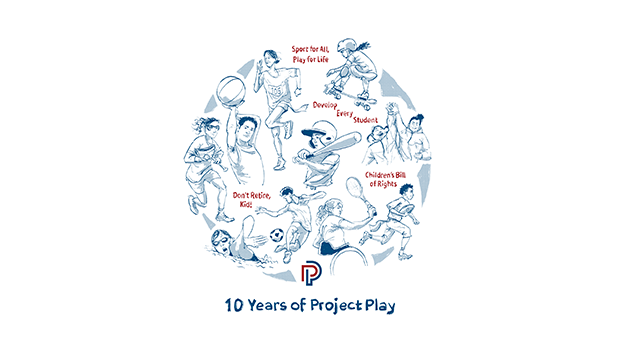
(Photo Credit: istockphoto)
*This article originally appeared in The Huffington Post.
Jon Brilliant is co-founder and chief financial officer of BigfootBiomedical.com, a company that is changing the paradigm of care for Type 1 diabetes through the creation of a service-based durable business model that includes the automated delivery of insulin. Brilliant participated in the Aspen Institute Sports & Society Program’s roundtable to identify new ways to get more recreation spaces funded and built in communities. Below, Brilliant explains how the funding model of the new Chan Zuckerberg Initiative could be effective in solving some of the biggest societal issues we face.
If I asked you to name an American hotbed of innovation, you would likely name locations such as Silicon Valley, Silicon Alley, and Austin, where technology startups define the culture and more broadly are shaping the future of the US economy. But what if the next place where innovation would spring from is not a physical place, but an entire segment of our economy?
I’m talking about the nonprofit sector.
With the stroke of a pen, none other than Mark Zuckerberg, with his recent announcement of the $45 billion Chan Zuckerberg Initiative, effectively signed on to the promise that hangs in the balance of disrupting the nonprofit sector.
Zuckerberg’s approach is unique. Instead of donating his money to charities to advance human potential and promote equality, the Chan Zuckerberg Initiative is aimed at solving some of society’s most pressing issues by looking to the nonprofit sector to identify the problems, then using the for-profit sector to achieve solutions. As Tech Crunch summed it up, the “configuration gives it the freedom and funding to take big swings at the causes of humanity’s troubles.” While the exact details of how Zuckerberg will do this are still unclear, it is highly likely that he will emulate the structure used by the Omidyar Network, arguably the first large-scale impact investor, which combines the culture of venture capitalists with that of foundations. The key is acting like a VC, backing the best management or expert leaders and giving them the resources they need to improve humanity in a sustainable way.
This model holds enormous promise in addressing, among other social problems, the epidemic of physical inactivity and the resulting health consequences, including obesity. We’ve all heard some version of the statistics: Fewer than half of children ages six to 11 meet the US surgeon general’s recommendation for engaging in at least 60 minutes of moderate physical activity most days of the week. Not surprisingly, according to the Centers for Disease Control and Prevention (CDC), childhood obesity has more than doubled in children and quadrupled in adolescents in the past 30 years. Today, one-third of children and adolescents are overweight or obese.

In response, the Aspen Institute Sports & Society Program launched Project Play, an initiative that provides stakeholders with the thought leadership to give all children the opportunity to get active through sports. As part of this effort, in October, I joined more than two-dozen experts in finance and other sectors at a roundtable to identify new ways to get more recreation spaces funded, built in communities.
The Project Play report, “Sport for All, Play for Life: A Playbook to Get Every Kid in the Game,” recognizes that business and industry play a key role in developing solutions — that the nonprofit sector cannot do this alone. I would go one step further and say that as a model for innovation, the nonprofit sector is dysfunctional. I said as much at a TEDx talk I gave.
Today’s nonprofit model is captured by the annual year-end campaigns that started just after Thanksgiving. No doubt you too faced the onslaught of solicitations from well-known and not-so-well-known nonprofits seeking to make their budget by knocking on the email boxes of organizations and individuals like you and me, holding out a virtual can into which they hope you drop funds.
It doesn’t have to be this way. Recently, with the Zuckerberg-Chan Initiative and other nascent efforts, seedlings have been planted to significantly disrupt the traditional nonprofit model as the place where some of the most pressing needs of our society are solved.
Consider social impact funds (SIF), a new way of deploying capital to achieve goals such as building more parks, and introducing quality youth sports programs that engage sedentary children. An SIF requires a funding source, an enterprise to fund, and a willingness for those generating a return to pay it forward to by returning funds to the social impact fund in order to fund future innovation.
We began testing this concept in 2014. As chairman of Start It Up Delaware (a for-profit entity), I launched a social impact fund with money from Discover Bank and the Verizon Foundation. In partnership with Health for America (a nonprofit) and Christiana Care Health System (a nonprofit), we set up a program to find a solution to the poor health outcomes for patients with congestive heart failure (CHF), a problem that disproportionately impacts low- to moderate-income citizens. We have developed a low-cost solution that has the potential to dramatically reduce health care costs and improve outcomes. Thirty percent of CHF patients are readmitted to the hospital, costing the health care system on average $13,000. We believe this can be avoided for less than $1,000 per patient.
If we are able to secure additional funding and successfully execute the company’s business plan, the structure of the initial financing is such that future returns on the financing will replenish a social impact fund. We will have solved a problem that the nonprofit sector hasn’t, and will have done so in an economically viable and self-sustaining manner through the creation of a for-profit solution.
An SIF is not to be confused with what is known as a social impact bond (SIB). In their simplest form, SIBs are “pay for success” bonds where the private sector says to the public sector, ‘If we solve a problem better than you have historically, we ask that you pay back those bonds with interest. If we don’t, there is no repayment obligation.’ Pioneered in the UK, SIBs were launched in the US in 2012 by New York City with backing from Goldman Sachs to tackle problems such as recidivism. These bonds have been a social experiment that relies on measuring their social impact (hence their name). But all the cases that have been evaluated have failed. From my perspective, the reason for this is that there is often disagreement or difficulty in establishing or measuring the social impact.
We can do better by doing something slightly different, which is the SIF model. Rather than being a partnership between the public sector and the private sector, a social impact fund is a partnership between the private, for-profit sector and the nonprofit sector, with the for-profit sector being a catalyst to solving nonprofit problems in a different way — a for-profit way.
The social impact fund is in line with the concept of the Chan Zuckerberg Initiative. As reported by the Wall Street Journal, that initiative is being structured like a social impact fund not in name, but in principal — “harnessing the profit motive on behalf of philanthropic goals,” “own[ing] stakes in for-profit businesses” and, most importantly, “the share of any profits from its investments will be used to renew its funds.”
Imagine this approach being used to develop some of the technology ideas presented in the Project Play report, such as a tool to survey all children in a community to capture what they want out of a sports experience so municipal, school, and recreation leaders can create and refine programs that meet the needs and interests of all kids. Or to fund the training of volunteer coaches. Or to finance before- and after-school sports programs that emphasize health outcomes and inclusion. The possibilities are endless, if the tens of billions of dollars from the health care industry and other sectors can be unleashed through an innovative model structured to deliver a double bottom line.
The social impact fund started as an idea in Delaware. It’s now been endorsed by Silicon Valley and one of the wealthiest families in the world. And it’s here to stay for a simple reason: Who doesn’t want to make money while improving the world?

